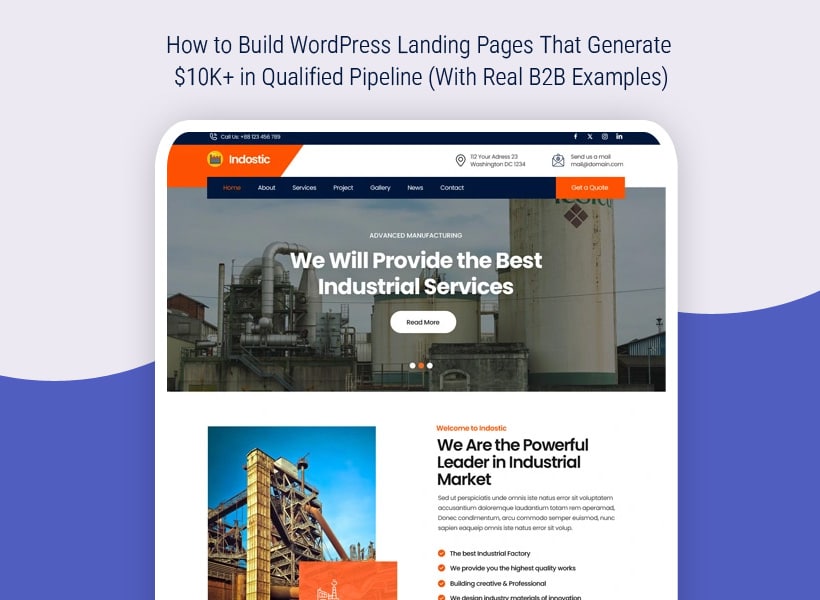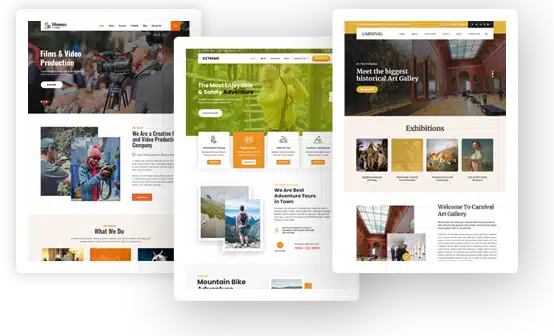How to Build WordPress Landing Pages That Generate $10K+ in Qualified Pipeline (With Real B2B Examples)

What if your WordPress landing pages could generate $10,000 in qualified pipeline from your existing traffic? While most businesses obsess over driving more visitors, smart B2B companies are discovering a more powerful truth: optimizing what you already have can multiply revenue without increasing your marketing budget.
The gap between website visitors and qualified pipeline represents one of the largest missed opportunities in B2B marketing today. This guide reveals a systematic approach to transforming your WordPress landing pages into revenue-generating assets.
The Hidden Revenue Crisis in B2B WordPress Sites
Why Traditional Landing Pages Fail B2B Companies
Most WordPress landing pages suffer from a fundamental misalignment: they’re built for aesthetics rather than business outcomes. This design-first mentality creates beautiful pages that fail to move prospects through the complex B2B buying journey.
The typical B2B WordPress site converts less than 2% of its visitors into leads. When you factor in lead quality, the numbers become even more sobering. Many companies discover that only 10-20% of their form submissions represent genuine sales opportunities, meaning their true conversion rate hovers around 0.2-0.4%.
This problem stems from treating all visitors equally. B2B buyers arrive at different stages of awareness and readiness. A senior decision-maker researching solutions requires different information than a junior employee gathering initial information. Yet most landing pages present the same generic message and basic contact form to everyone.
The True Cost of Poor Landing Page Performance
Consider a B2B service company with an average deal size of $50,000 receiving 5,000 monthly visitors. At a 2% conversion rate with 20% lead quality, they generate 20 qualified leads monthly. Improving conversion to 3% and lead quality to 40% would yield 60 qualified leads – tripling their pipeline without additional traffic.
The indirect costs prove equally significant. Sales teams waste hours pursuing unqualified leads, reducing time spent on genuine opportunities. Marketing budgets drain into driving traffic that never converts. Poor landing page performance creates a negative feedback loop where low conversion rates increase cost per acquisition, reducing available budget for testing and improvement.
The Revenue-Generating Landing Page Framework
Component 1: Value Proposition Alignment
Effective B2B landing pages begin with crystal-clear value proposition alignment. This means understanding not just what you offer, but how it translates into measurable business impact for your prospects. The most successful pages speak directly to the financial outcomes decision-makers care about: increased revenue, reduced costs, improved efficiency, or competitive advantage.
Map your value proposition to specific roles within target organizations. A CFO evaluating your solution needs to understand ROI and payback period. An IT director wants to know about implementation complexity and security. A marketing manager focuses on user adoption and results timeline.
The key lies in leading with outcomes rather than features. Instead of listing capabilities, demonstrate how those capabilities translate into business results. Replace “advanced analytics dashboard” with “reduce reporting time by 75% while improving decision accuracy.” This outcome-focused messaging resonates with B2B buyers trained to think in terms of business impact.
Component 2: Trust Architecture
B2B purchases involve significant risk. Decision-makers stake their reputation on vendor choices, making trust essential for conversion. Effective landing pages systematically build credibility through strategic placement of credibility indicators throughout the user journey.
Trust architecture begins with immediate credibility markers above the fold. This includes recognizable client logos, industry certifications, or impressive metrics. As prospects scroll, layer in progressively detailed proof points: case studies with specific results, testimonials from similar companies, security certifications, and compliance badges.
Position client logos near your value proposition to create immediate association. Place testimonials adjacent to key claims to provide third-party validation. Include security badges near forms to address data concerns at the moment of conversion. Remember that B2B trust differs from B2C – buyers seek evidence of expertise, reliability, and relevant experience.
Component 3: Conversion Path Optimization
The journey from visitor to qualified lead requires careful orchestration. B2B conversion paths must balance the need for qualification with the reality of user patience. This is where strategic form optimization techniques become crucial for maintaining engagement while gathering essential information.
Progressive disclosure represents one of the most powerful strategies for B2B conversion optimization. Rather than presenting a lengthy form upfront, break the information gathering into logical steps. Start with low-commitment questions that provide value to the prospect, then gradually request more detailed information as trust builds.
Consider offering multiple conversion paths at different commitment levels. A visitor not ready for a sales conversation might download a relevant guide. Someone comparing solutions might use an ROI calculator. A prospect ready to buy might schedule a demo. Each path serves a specific intent while moving prospects closer to a sales conversation.
Component 4: Intelligent Lead Capture
Modern B2B lead capture extends far beyond basic contact forms. Intelligent systems gather behavioral data, qualification signals, and buying intent indicators that help sales teams prioritize and personalize their outreach.
The foundation of intelligent lead capture lies in asking the right questions at the right time. Early-stage forms might focus on company size and industry to provide relevant content. Mid-stage forms could explore specific challenges and timeline. Late-stage forms might include budget ranges and decision-making process details.
Field selection requires careful balance. Every additional field reduces conversion rates, but insufficient information wastes sales time. Focus on fields that directly impact sales strategy: company size determines pricing tier, industry shapes use cases, role influences messaging, and timeline affects follow-up urgency.
Measuring Revenue Impact
Traditional metrics like page views and bounce rate provide limited insight into B2B landing page performance. Revenue-focused measurement tracks indicators directly tied to business outcomes.
Pipeline value per visitor represents the north star metric for B2B landing pages. Calculate this by multiplying conversion rate, lead-to-opportunity rate, and average deal size. This approach reveals which efforts genuinely drive revenue growth rather than vanity metrics.
Lead velocity and quality metrics provide early indicators of revenue impact. Track not just quantity of leads but their progression through sales stages. Monitor which landing page variants produce leads that convert to opportunities faster and at higher rates. These leading indicators enable quick optimization without waiting for deals to close.
Common Pitfalls to Avoid
The quantity trap represents the most dangerous pitfall. Celebrating increased lead volume without examining quality creates false confidence while burning through sales resources. A lower conversion rate producing higher quality leads often generates more revenue than high-volume, low-quality approaches.
Technical complexity can derail implementation. While sophisticated tracking and personalization sound appealing, they must be balanced with maintenance capability. Start with simple, high-impact optimizations before adding complexity.
Disconnection from sales remains surprisingly common. Marketing teams optimize for metrics that don’t align with sales success. Regular communication with sales teams reveals which leads convert best and why. Use this feedback to refine targeting, messaging, and qualification criteria.
Implementation Best Practices
Success begins with strategic clarity. Document your ideal customer profile, average deal size, and typical sales cycle. This foundation guides every subsequent decision, from messaging to form fields to follow-up sequences.
When implementing advanced form optimization strategies, focus on multi-step forms with conditional logic. These reduce psychological barriers by presenting fewer fields at once while enabling personalization based on previous answers. A three-step form asking for basic information, company details, and specific needs often outperforms a single long form with identical fields.
Integration capabilities multiply the value of captured data. When landing pages connect seamlessly with CRM systems, marketing automation platforms, and sales tools, every interaction enriches the prospect profile. This integration enables sophisticated lead scoring, automated routing, and personalized follow-up that dramatically improves conversion rates.
The Path Forward
Building revenue-generating WordPress landing pages requires more than technical implementation. It demands strategic thinking, systematic execution, and relentless focus on business outcomes. The framework outlined here provides a proven path, but success ultimately depends on commitment to continuous improvement.
Start with one landing page. Apply these principles systematically. Measure actual business impact. Learn from results and iterate. The opportunity is clear: your existing traffic contains untapped revenue potential. By optimizing landing pages for business outcomes rather than vanity metrics, you can generate significant pipeline growth without increasing marketing spend.
Remember, the difference between a good landing page and a great one isn’t in the design—it’s in the revenue it generates. Focus on that, and everything else falls into place.

